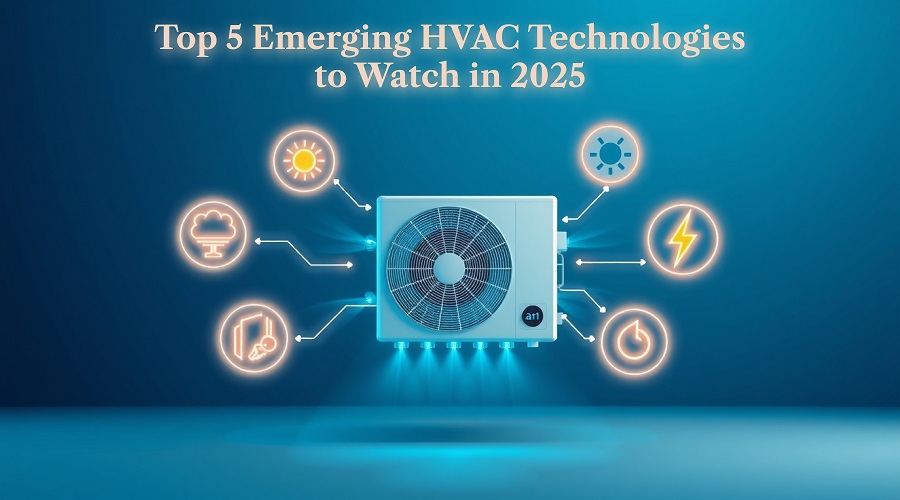Ever walked into a building and wondered why it feels too warm or too cold? The answer often lies in the hidden air flow and temperature control systems. According to Global Market Insights the global Heating, Ventilation, and Air Conditioning (HVAC) market was valued at USD 310.6 billion in 2024.
In a typical office nearly 40 percent of energy is used by HVAC with 34 percent for fans, 27 percent for cooling and 17 percent for heating. With rising energy costs and a push for sustainability, 2025 promises to be a turning point.
Variable Refrigerant Flow Systems
Ever wished for more control over individual rooms in your building? Variable refrigerant flow (VRF) systems might be your answer. These systems adjust refrigerant delivery to each indoor unit based on real time demand. In many tests VRF setups have shown up to 22 percent energy reduction when compared to fan coil unit and variable air volume systems, helping HVAC energy use drop significantly.
They also let you set different temperatures in different zones without heating or cooling the entire building, making them ideal for mixed use spaces.
Energy Recovery Ventilators
If you ever peeked behind a ventilation grill you might be surprised at how much energy goes right out the door. Energy recovery ventilators (ERV) capture heat and moisture from exhausted indoor air and transfer it to incoming fresh air.
Most ERVs can recapture between 40 and 80 percent of the energy in the outgoing air stream, which lowers the work on core systems and boosts HVAC efficiency. Adding an ERV can help you keep air fresh without sending energy bills through the roof.
Smart Thermostats with Artificial Intelligence
Gone are the days of setting a schedule and hoping it works out. Smart thermostats now use artificial intelligence to learn your daily patterns and adjust settings in real time. A whitepaper analysis found that these learning thermostats saved an average of 9.6 percent on heating energy and 17.5 percent on cooling energy across hundreds of homes. They link to smartphones, letting you control temperature from anywhere and deliver ongoing efficiency gains for HVAC systems.
Magnetocaloric Cooling
Imagine cooling without any chemical refrigerants. Magnetocaloric cooling uses special materials that heat up when exposed to a magnetic field and cool down when it is removed. This next generation HVAC technology offers potential energy savings of 20 to 30 percent over conventional vapor compression systems and avoids chemical refrigerants.
Though still in prototype stage, magnetocaloric cooling promises a solid-state path to sustainable cooling in data centers and research labs.
Solar Assisted Heat Pumps
What if your air conditioning could run partly on sunshine? Solar assisted heat pumps combine photovoltaic thermal panels with heat pump systems to boost performance. In 2024 the global market for these setups reached USD 2.5 billion and it is forecast to grow to USD 6.8 billion by 2033 as more building owners look for renewable methods to power HVAC systems. These solutions cut grid demand and reduce utility bills in both homes and commercial spaces.
Conclusion
The future of HVAC is happening now. These emerging innovations promise real benefits in energy savings, comfort and sustainability. By adopting variable refrigerant flow systems, energy recovery ventilators, smart thermostats, magnetocaloric cooling and solar assisted heat pumps, building owners can cut costs, shrink their carbon footprint and keep occupants happy.
FAQs
1. What is a variable refrigerant flow system?
A VRF system adjusts refrigerant delivery to individual zones based on real time demand for improved comfort and energy efficiency.
2. How does an energy recovery ventilator work?
An ERV captures heat and moisture from outgoing air and uses it to pre condition incoming fresh air, reducing the load on core systems.
3. How much can a smart thermostat save?
Studies show learning thermostats can save about 9.6 percent on heating and 17.5 percent on cooling energy over one year.
4. Is magnetocaloric cooling available now?
Magnetocaloric cooling is in prototype stage but shows promise as a clean and energy efficient option for niche applications.
5. Are solar assisted heat pumps worth the investment?
Growing market data and falling panel costs make solar assisted heat pumps a viable option for long term energy and cost savings.





Comments